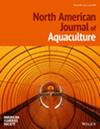Effects of broodfish sex ratio, broodfish stocking density, and post‐spawn broodfish holding‐pond density on reproductive efficiency in pond‐spawned Channel Catfish, Ictalurus punctatus
IF 1.3
4区 农林科学
Q3 FISHERIES
引用次数: 0
Abstract
Abstract Three trials were conducted to determine the effects of broodfish management on reproductive efficiency of pond‐spawned Channel Catfish, Ictalurus punctatus. Trial 1 compared male to female broodfish sex ratios of 1:1 vs. 1:4; Trial 2 compared low (1,065 kg/ha) vs. high (2050 kg/ha) broodfish stocking densities; and Trial 3 compared low (1525 kg/ha) and high (5,780 kg/ha) post‐spawn broodfish holding‐pond densities on measures of reproductive efficiency. Males had lower survival than females in all trials. Age, weight, and survival of broodfish were similar for each treatment within trials. A higher percentage of females spawned at the 1:1 male to female ratio than at the 1:4 ratio (40.8% vs 12.5%), resulting in more eggs/ha, eggs/kg of broodfish, fry/ha and fry/kg of broodfish for the 1:1 ratio compared to the 1:4 ratio. Male spawning success (~31%) was similar for 1:1 and 1:4 sex ratios. Spawning fish weighed more than non‐spawning fish for both sexes and surviving males weighed less than non‐surviving males in Trial 1. In Trial 2, the percentage of egg masses collected per female stocked was higher for the high broodfish density than the low density (34.0 vs. 16.4%), resulting in more eggs/ha and fry/ha for the high stocking density resulting in whole‐farm economic benefits ranging from $323‐828/ha primarily from the reduction in the area required for broodstock. Results indicate the 1:1 male to female broodfish ratio (Trial 1) and high broodfish stocking density (Trial 2) resulted in better reproduction than the 1:4 sex ratio and low broodfish stocking density. The effects of low vs. high broodfish holding‐pond densities didn't affect reproductive output.鱼类性别比、放养密度和产卵后池养密度对池产卵槽形鲶鱼繁殖效率的影响
摘要通过3项试验,研究了养鱼管理对池产海峡鲶鱼(Ictalurus punctatus)繁殖效率的影响。试验1比较了雄雌亲鱼的性别比为1:1 vs. 1:4;试验2比较了低(1065公斤/公顷)和高(2050公斤/公顷)亲鱼放养密度;试验3比较了低密度(1525公斤/公顷)和高密度(5780公斤/公顷)的产卵后池育鱼密度对繁殖效率的影响。在所有试验中,男性的存活率都低于女性。在试验中,每次处理的亲鱼的年龄、体重和存活率相似。与1:4的比例相比,1:1的雌鱼产卵比例更高(40.8%对12.5%),导致1:1的比例比1:4的比例更多的卵/公顷、卵/公斤亲鱼、苗/公顷和苗/公斤亲鱼。雌雄比例为1:1和1:4时,雄鱼产卵成功率(~31%)相似。在试验1中,无论性别,产卵鱼的体重都大于非产卵鱼,而存活的雄鱼的体重低于非存活的雄鱼。在试验2中,高亲鱼密度比低亲鱼密度高(34.0比16.4%),导致高放养密度的雌鱼每公顷收获更多的卵和鱼苗,导致整个农场的经济效益在323 - 828美元/公顷之间,主要是由于亲鱼所需面积的减少。结果表明:1∶1雄雌比(试验1)和高放养密度(试验2)比1∶4雄雌比和低放养密度(试验2)繁殖效果好。养鱼池密度高低对繁殖产量没有影响。
本文章由计算机程序翻译,如有差异,请以英文原文为准。
求助全文
约1分钟内获得全文
求助全文
来源期刊
CiteScore
2.50
自引率
0.00%
发文量
46
审稿时长
18-36 weeks
期刊介绍:
The North American Journal of Aquaculture publishes papers on new research and practical experience in all areas of intensive and extensive fish culture. Topics include broodstock selection and spawning, nutrition and feeding, health and water quality, facilities and production technology, and the management of ponds, pens, and raceways.
The journal will consider papers dealing with ways to improve the husbandry of any aquatic species—marine or freshwater, vertebrate or invertebrate—raised for commercial, scientific, recreational, enhancement, or restoration purposes that may be of interest to practitioners in North America. Its scope includes both basic and applied science, but applied scientific endeavors—including practical experiences, descriptive studies, and other nontraditional, but pertinent works—are emphasized.

 求助内容:
求助内容: 应助结果提醒方式:
应助结果提醒方式:


